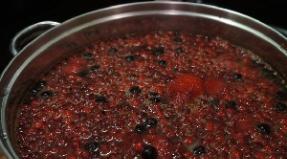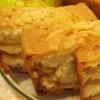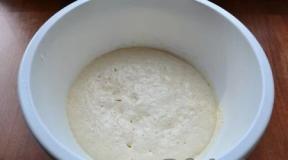Frozen eggplants for the winter: baked, fried, blanched. How to freeze eggplant whole and sliced for the winter
Do I need to freeze eggplants for the winter? After all, fresh "blue" ones in the cold season have long ceased to be something akin to fabulous snowdrops in the pre-New Year's time. Almost black and purple fruits from warm countries are on the shelves almost all year round. They lie to themselves, gleam with varnish barrels ... But there are not so many who want to buy them. The price, you know, is not conducive to inspiring culinary creativity and pleasant absorption of its results. So let's take care of the eggplant sleigh in the summer. We will freeze eggplants in several ways!
How to freeze fresh eggplant
I bet you can't tell the taste of frozen eggplants after defrosting from fresh ones? Having the sad experience of freezing "little blue" ones without blanching, I know what I'm talking about. Why don't you freeze a couple of small fruits too? In winter, your culinary imagination will have a place to play out!
Sequencing:
- Choose young, ripe eggplants for freezing without damage, with a smooth, shiny skin.
- Cut the "blue" into small cubes (for pickling), a standard cube (for making stews, soups, caviar, mashed potatoes) or moderately thin (0.4-0.5 mm thick) circles (for frying). In order for frozen eggplants to retain their shape and taste as much as possible after defrosting, they need to be removed from the liquid. Add coarse salt to the eggplant slices and stir. Let them sit at room temperature for a few hours. Then drain the darkish juice that has come out. Rinse off any remaining salt under running water. Squeeze lightly so as not to deform the pieces too much.
- Now you need to blanch the workpiece.
This can be done in several ways:
- Fill the pot halfway with clean water. Bring to a boil. Dip the eggplant and blanch for 2-4 minutes. They will become softer, but not boiled over.
- Place the blue ones in a large microwave-safe pot. Pour in some water. Cover with a lid. Place in a microwave oven. Turn on the device at a power of 800-900 W for 3-4 minutes.
- You can blanch vegetables in a double boiler. You need to process eggplants in this way within 2-4 minutes.
Advice. You can defrost eggplants prepared for the winter in this way in the main compartment of the refrigerator or at room temperature. It is advisable not to use a microwave oven. Delicious, almost fresh vegetables (or berries?) Are ready to participate in your culinary experiments and proven dishes.
Freezing fried eggplants

Method for freezing fried eggplant:
- To freeze fried fruits, you first need to fry them, this is logical. Wash the blue ones selected for roasting and freezing. Cut off the ends. Cut as you are used to - not very thick circles or thin slices. To prevent the eggplants from absorbing a lot of oil and not being bitter when frying, cover them with salt. Wait a few hours for the juice to come out.
- Drain and rinse the eggplant slices. Pat dry with paper towels. Heat some refined vegetable oil in a skillet or saucepan. Fry the eggplant on both sides.
- To absorb excess fat after frying, place the slices on a small stack of paper towels rather than on a plate.
- Wait for the eggplant slices or slices to cool completely. Take a large cutting board (tray). It should fit freely into the freezer compartment in your fridge or freezer. Wrap with cling film. Close to each other (but not overlap), lay out the fried eggplants in one layer for freezing. Then wrap with plastic again. Repeat layers until you run out of eggplants.
- Place the blue ones in the freezer. Check the degree of frost after a few hours.
- If the eggplants are done, remove the board. Unroll the film. Divide the entire amount of the vegetable into small portions. Divide into freezer bags. Remove air from packaging and tie neck or zip lock.
Store fried frozen eggplant for up to six months in the general freezer. Defrost before use and brown lightly in the pan if desired.
Freezing baked eggplants

Cubes or circles
The method is very simple. Peeled, sliced, baked, frozen. Everything! Now let's take a closer look at this simplified scheme for freezing baked eggplants.
Procedure:
- Freezing baked blues is easy. The longest process is preparation. Wash beautiful ripe eggplants without visible damage. Dry off with a towel.
- Peel the skin if desired. Cut into cubes or circles. If desired, you can sleep with salt to remove the bitterness. Rinse the slices, squeeze lightly.
- Place on a baking sheet, greased with odorless vegetable oil. Preheat the oven to 170-180 degrees. Place the eggplant baking sheet on the middle rack of the oven. Bake until tender. This will take 30 to 60 minutes depending on the size of the cut and the amount of the vegetable.
- The baked "blue" ones should cool completely before freezing. Blot off oil and moisture. Distribute in freezer bags or special containers with a lid.
- Place in quick freezer for several hours. Move to the general freezer compartment. A semi-finished product for stews or delicious vegetable caviar is ready!
Method for the lazy or Freezing whole baked eggplants
This way of freezing baked fruit is even easier. "Little blue" ones are baked whole. However, then you can cut them as you like.
How will we freeze:
- Wash a few small eggplants. Wipe them off.
- Puncture the fruit in several places with a fork.
- Place on a baking sheet with a little olive oil or deodorized sunflower oil. Bake at 200 degrees for about half an hour.
- Cool the finished eggplants. Peel off. Squeeze out the juice lightly.
- Chop the fruit, or leave it intact, if desired. Divide into freezer bags. Freeze. Store in the freezer until winter.
Happy freezing!
Freezing vegetables and fruits is a great option for preparing for the winter. Freezing eggplants is no exception. After all, it is very cool to taste a real summer dish amid the winter cold and frost. Of course, you can buy fresh vegetables in winter, but the price for them is very high, so not everyone can afford it.
You can even freeze eggplants in your freezer. In this article, we will consider all possible options for this process.
Freezing fresh eggplants for the winter
In order to freeze fresh eggplants, you need to purchase young, well-ripened eggplants. Make sure that the vegetables are completely intact, without damage. Then it is worth deciding for what purposes you will use the eggplant. It can be blanks for marinating, for making stews, as well as for frying eggplants. Depending on this, cut the eggplants into the appropriate shape (cubes, cubes, circles). Then you should fill the eggplants with coarse table salt and leave for several hours. This is done in order to get rid of excess liquid in the eggplants, which will allow them to preserve their structure as much as possible after defrosting. After the eggplants have released their juice, they must be rinsed with running water and dried with a paper towel. After all this, it is recommended to blanch these vegetables.
How to Blanch Eggplant Properly
- The first way. Prepare a saucepan, fill it halfway with water, and bring it to a boil. Dip the prepared eggplants in boiling water for literally 3 minutes. This will allow them to become softer, but at the same time they will not boil at all.
- Second way. Place the eggplants in a microwave-safe container. Then add a little water and cover. With a power of 900 W, the time of such a procedure will be about 4 minutes.
- Third way. You can also carry out this process using a double boiler. The time of such a process is also 4 minutes.


What to do next
- After the eggplants have already undergone heat treatment, they should be thrown in a colander.
- We wait until all the liquid drains and the eggplants cool down.
- We divide them into several parts, depending on how many of them you need to prepare one portion.
- We put it in a pre-prepared container (it can be either containers or plastic bags) and send it to the freezer.
- It is necessary to defrost eggplants at room temperature or simply in the refrigerator compartment.


How to freeze fried eggplant
In addition to fresh eggplants, you can also freeze roasted ones. This saves you a lot of time, because they are almost ready-to-use. You just have to unfreeze them. Now let's take a closer look at this process.
- First you need to fry our eggplants. For this, my prepared vegetables. Mode with the form we need, salt and leave for a while so that all the liquid we do not need is glass. Then we take a frying pan and heat refined vegetable oil on it. Fry vegetables on both sides.
- Then, so that the eggplants are not too greasy, they should be laid out on a plate on which there are paper napkins or towels. When they have cooled down, you can proceed to direct freezing. To do this, you need to take a board that will fit in the freezer drawer. Cover it with cling film, lay out a layer of fried eggplant. Then on top of this layer we once again lay cling film and again we can lay our workpiece. We send this to the freezer. After a while, when the eggplants are frozen, they can be transferred to a regular freezer container. Such fried eggplants can be stored in your freezer for up to six months.


Freezing baked eggplants
Baked eggplants are very good for feeding babies. You just need to defrost them and kill them in a blender. This freezing procedure is no different from fried ones. The only difference is that we bake rather than fry. It is worth baking in a baking sheet, which is pre-lubricated with vegetable oil. The optimum oven temperature is 180 degrees. Roasting time usually takes between 30 minutes and up to one hour. It depends on the size of the vegetable.


As we can see, you can freeze both raw and fully prepared vegetables. It is always healthy and tasty. When preparing blanks for the winter, you know that there are no preservatives and all this is fried in good oil. That is why homemade products are always preferable to purchased ones. Freeze vegetables and indulge yourself and your family on cold winter evenings with summer treats!
Recipe " How to freeze eggplants for the winter»Offers one of the best ways to preserve vegetables for a long time. Deep frozen, they will not deteriorate for months, will retain their taste and most of the vitamins, and you will not have to apply complex treatments to them. Of course, compared to bell peppers or zucchini, eggplant when frozen requires a more careful approach and additional manipulation.
Is it possible to freeze eggplants at all? After all, this vegetable has a specific taste, which, if frozen incorrectly, can change in a negative direction. Yes, you can freeze eggplants, but not raw. But if, nevertheless, they are harvested raw, then they are stored at a temperature of -12 C and no more than 5 months. Eggplants themselves do not smell when frozen, but they are able to absorb foreign odors. For example, from aromatic dill, which, even in the freezer, is capable of smelling all neighboring products. Therefore, when freezing eggplants, they must be sealed in a suitable container. It is not recommended to freeze eggplants together with other vegetables. Here, as in every culinary recipe, there are small ones.

How to freeze eggplants for the winter is useful and right at home? There are three main pre-processing methods for this: fry, blanch, or soak. But it is advisable to use the third method for the first two options as well. Whichever method is chosen, it would be good to first wash the eggplants thoroughly, cut off the stalks from them and cut them into convenient pieces (bars, cubes, circles, straws, etc.). And the smaller or thinner the pieces are, the faster they will freeze. After that, the pieces are transferred to salted water and kept in it, thereby removing the excess bitterness that these vegetables have. The soaked eggplants are laid out on a paper towel (it is better not to use linseed, as the pulp can stick to it) and left on it until dry.
So, as mentioned above, such options are possible " How to freeze eggplant for the winter quickly»:
- fry the soaked eggplants in a frying pan in a little vegetable oil and cool;
- blanch the pieces of vegetables by dipping them first in boiling water, and then in ice water, completing this procedure by drying (it is better not to put wet eggplants in the freezer);
- just dry the soaked eggplant pieces and put them in a convenient container for storage in the freezer.

It is advisable not to use ordinary plastic bags for packaging eggplants. It is best to store vegetables for several months in plastic containers. In this case, you need to try to arrange the eggplants more tightly to each other, compactly; so they freeze faster and take up less space. But you do not need to place them close to each other, otherwise in the future for defrosting, in order to pull out a certain number of pieces, you will have to break them off from the total mass or break it.

On average, small cubes of eggplant take about 4-5 hours to freeze in the freezer. And you can defrost them in the microwave, right in the pan, or simply by laying them out in one layer on a cutting board or other surface. But you don't need to defrost them in hot water or with other vegetables. It is important to remember exactly how the vegetables were frozen. If they were previously fried, then too long processing is not needed. But raw ones must be properly fried, stewed, boiled, like ordinary vegetables. You can even sign a container with frozen eggplants, because it is rather difficult to distinguish the pieces in frozen form and determine which one was used.

Eggplants, in comparison with other vegetables, can be called finicky, with their own specifics and characteristics. And not every housewife succeeds in freezing them correctly the first time. But everything is not so difficult, if you carefully delve into it! The main thing is to disassemble recipes "How to freeze eggplants for the winter" in order and when preparing, strictly adhere to the recommendations of the recipes. Let's consider in detail the following two methods.
Method 1 - freezing whole eggplants with pre-frying
First of all, only whole, ripe vegetables are selected for harvesting, without spoilage and dented places. Then they are washed out, the tails are cut from them, and they are left to dry. The second step is to place the dried, clean eggplants in a dry skillet without oil and fry them on all sides over low heat until they are slightly soft. During frying, eggplant should be turned over regularly; so excess moisture and bitterness will go away from them. Next, the baked vegetables are peeled, and each of them is wrapped in cling film. They can now be transferred to a suitable freezer container and stored in the freezer. The advantage of this method is that frozen eggplants can be taken out of the freezer one at a time, avoiding defrosting unnecessary portions.

Method 2 - freezing eggplant in pieces with pre-blanching
The second method differs from the first in that the vegetables will be frozen in cut circles or cubes. So, washed eggplants are cut, sprinkled with salt and left for 30 minutes so that they "drain" and get rid of the bitter taste. Then the pieces are blanched: they are placed in a colander and dipped into boiling water for 1-2 minutes, and then sharply into cold water. Next, the mugs or cubes are laid out on a paper towel (this way they dry faster) and then folded into airtight containers for freezing in the freezer. Store these eggplants in small portions, making sure the storage container is free of unwanted moisture.

There is no doubt that there is nothing better than fresh vegetables! They contain both trace elements and vitamins ... But what if the season ends and you have to say goodbye to them? Then "How to freeze eggplants for the winter" recipes will be a great help and help to stock up on a tasty and fresh piece of summer. Pickles, canned and pickled are all good. But, unfortunately, they are already of little use. Then there is only one way out - home freezing!
How to freeze eggplants for the winter in the freezer at home without spoiling the product is described in detail in our article. Peculiarity eggplant lies in the fact that for freezing their taste and structure change significantly. For this reason, it is important to follow certain rules of this process. It should be noted that for freezing fresh eggplants it is possible to store nutrients in greater quantities than canned vegetables, which is an undoubted advantage.
How to choose the right fruit
 Take away eggplant according to the same rules that are used for canning:
Take away eggplant according to the same rules that are used for canning:
- Peduncle. The color of the tail of the fruit should be green. Eggplant, whose stalk is dry, freeze it does not follow. Since this indicates that the vegetable was stored for a long time after being plucked from the bush;
- Surface quality. Surface eggplant should be glossy, it should be free of bumps, growths, damage and spots - such a fruit is most suitable for freezing;
- Color. It is necessary to choose fruits that are evenly colored;
- Maturity and size. Best for frosts fit young eggplant, since large and ripe fruits contain a large number of seeds. Their skin and flesh are tighter.
Advice! To avoid the production of the poisonous substance solanine in eggplants, a significant concentration of which is harmful to the health of the body, during storage they should be protected from light. Even a small amount of this component in a vegetable gives it a bitter taste.
Slicing eggplant, received the popular name - blue, you should pay attention to the color of the cut. Its rapid darkening indicates that the fruit will be bitter, since it contains large quantities of solanine. For frosts vegetables with a light cut are more suitable.
How to freeze eggplant fresh for the winter
Freezing blue, you should provide them with airtight storage. Sliced vegetables are placed in a tightly closed package, which prevents penetration to eggplant air in the refrigerator. Thus, the oxidation of the fruits and the penetration of foreign odors from other products stored in the freezer are prevented. This advice, like the ones described below, helps you to implement the correct freeze eggplant using any of the proposed methods.
It is easy to ensure the tightness of the package using a vacuum apparatus, but you can do without it. Wherein, freezing vegetables, use zip bags and regular cocktail tubes. After placing the vegetables, the bag is closed almost completely, leaving only a small access for the plastic straw. Having pushed it inside the bag, the air is pulled out of it with the mouth until the walls of the package stick to the vegetables. Then the tube is carefully removed and the bag is closed completely.
For frozen eggplants at home, you must complete the following steps:
- Pre-soak. You should not abandon this stage of preparing the fruit, otherwise bitterness may remain in them, which will make the product unsuitable for consumption. For this reason, before frosts it is recommended, first of all, to soak the chopped eggplant in a solution of water with salt, after which they must be washed well in clean water;
- Remove moisture. Before placing in the freezer, the pieces eggplant should be dried from emerged water or excess vegetable oil by blotting with a paper towel;
- Sign packaging. In the freezer, plastic containers and bags with vegetables are covered with frost, from which all containers become similar to each other, and determine exactly where they are, for example, eggplant it is not easy.
Reference! The sealed packaging allows you to store frozen eggplants in the freezer (at a temperature of -12 ° C) for no more than a year. Exceeding this shelf life negatively affects the taste characteristics of the blue ones.
Important! It is better to freeze eggplants in portions, as much as you need at a time. Otherwise, with repeated freezing and defrosting, they lose their taste and useful elements.
Freezing eggplant processing options
Frying
Is it possible to freeze eggplants for the winter fried? Yes.

- Wash up eggplant, cut into slices up to 0.7 cm thick.If you cut them thinner, the pieces will become even smaller during the frying process and will not be suitable for freezing in the freezer;
- To get rid of the bitterness, salt the vegetables and wait about 30 minutes. Then rinse with clean water;
- Place pieces on a grill, baking sheet or similar surface and leave to dry. You can get wet to speed up the process. eggplant using a paper towel;
- Add a little vegetable oil to a hot pan and fry the circles lightly eggplant a few minutes on each side. The pieces stop frying when they have a light golden crust;
- Arrange the circles eggplant on a wire rack, cool to room temperature and place in the refrigerator chamber for washing R Ozki at temperatures below -12˚С;
- After 90 minutes eggplant take them out of the freezer, remove them from the grate and put them in bags, sending them back to the freezer, where they are stored until use;
- Stick stickers on bags with eggplant, indicating the name, weight and method used to prepare the product for freezing;
- You can cut the blue ones into cubes or cubes, depending on the cooking plans after defrosting the vegetables.
Baking
- Slice eggplant into circles or slices, which are great for the subsequent preparation of rolls;
- Preheat the oven until the temperature in it reaches 180 ° C;
- Place the blue ones on a baking sheet greased with vegetable oil and send them to the oven for half an hour;
- After a quarter of an hour, turn the pieces over so that both sides of the chopped eggplant;
- Then repeat the same steps as indicated for fried eggplant: dried, placed in the freezer for 30 minutes, packed in packages as much as needed for 1 time, ensure tightness inside them, stick stickers, and then stored in the freezer until use.
Extinguishing

- Add a small amount of vegetable oil to the saucepan and heat it up;
- Lay out the pieces eggplant and, stirring from time to time, simmer vegetables until tender, you can add salt and pepper to taste;
- Remove from heat and cool to room temperature;
- Shift stews eggplant in packages or containers and send to freeze into the freezer.
Blanching
- Pour water into a saucepan, boil, salt well and add 1 tbsp. a spoonful of lemon juice (you can squeeze fresh juice from half of the fruit);
- Pieces eggplant boil in boiling water for about 5 minutes;
- Remove vegetables with a slotted spoon and immediately lower them into ice water;
- Take out, dry eggplant;
- After that, the blue ones can freeze.
Cooking
- Cut off the tails of the fruit, pierce deeply in different parts eggplant a needle or toothpick;
- Soak vegetables for 45 minutes in a solution of sodium chloride, removing bitterness, such a long time is necessary due to the fact that the processing of blue ones is carried out as a whole, not chopped up;
- Pour water into a saucepan, boil, then boil in it for 20 minutes eggplant, from which the bitterness was previously removed;
- During the boil, vegetables shrivel, they should be cooled and chopped using any convenient method, after which the product is ready for freezing.
Freezing whole fruit

- Eggplant exposed to high temperatures without peeling. To do this, vegetables in their entirety can be sent to stew in a multicooker, bake with a grill or cook using the method described above;
- Then cool the blue ones and dry the moisture from their surface with a paper towel;
- Carefully wrap the vegetables individually in a dense layer in plastic wrap and send to the freezer.
Advice! You can freeze whole eggplant fruits by keeping the skin or peeling vegetables from it, depending on the form in which they will be eaten.
Blanks for rolls
It is incredibly convenient to make rolls from frozen eggplant, using special blanks. For this:
- Rinse and dry vegetables without peeling;
- Remove stalks, cut eggplant lengthwise into long slices 5-8 mm thick;
- Fold into a container of a suitable size, salt each layer;
- Leave for half an hour, then rinse well in clean water and dry;
- Lay out slices from eggplant one layer on baking paper, which is covered with a baking sheet, and bake in the oven at 200 ° C for about 15 minutes;
- Eggplant be sure to bake in one layer, if necessary in several batches;
- Then take out the baking sheet and cool the vegetables;
- Spread cling film on a tray, spread the "tongues" eggplant in one layer, if necessary, place many layers, cover each layer on top using a film, after which freeze pieces for several hours;
- Then take out the blanks and arrange them in bags or containers, getting rid of the film.
Defrosting rules
Freezing vegetables are recommended to be carried out no more than once. Therefore, the repeated freezing eggplants after thawing is prohibited. For this reason, it is necessary to properly distribute the portions of blue in the packages before placing them in the freezer. In this case, you can easily use the amount of vegetables that is required in each specific situation. Further, there are the following ways to use the product:
- To unfreeze eggplant, you can simply take them out of the freezer, lay them out on a large plate and leave them to defrost at room temperature, without using auxiliary electrical appliances;
- To prepare some dishes, you do not need to defrost vegetables, in this case, start frying or boiling eggplant you can immediately after they were taken out of the freezer.
Watch the video! How to properly freeze eggplants for the winter
Frozen eggplant recipes
Eggplant caviar
We need:
- 1 kg eggplant;
- 3 onions;
- 3 carrots;
- 70 ml of sunflower oil;
- Salt, pepper, spices to taste.
How to cook:
- fry onions and carrots;
- add defrosted eggplant, cut into cubes, salt, pepper, season with spices;
- stew, when the dish is almost ready, add a little chopped garlic;
Fried potatoes with blue
 We need:
We need:
- 0.5KG eggplant;
- 2 onions;
- 0.5 potatoes;
- 70 ml of sunflower oil;
- 2 cloves of garlic;
- Salt, pepper, spices to taste.
How to cook:
- in different pans, fry the onions with potatoes and eggplant, cut into cubes or circles;
- then mix the ingredients and fry a little more, adding a small amount of garlic, spices and herbs.
Eggplant rolls

- defrost the "tongues" of the blue ones, put the filling on top to taste, place in a baking dish;
- grate the cheese and sprinkle on the pieces eggplant, bake in the oven until the food is ready.
Vegetable stew
 We need:
We need:
- 0.5KG eggplant;
- 3 onions;
- 3 carrots;
- 3 bell peppers;
- 2 tomatoes;
- 70 ml of sunflower oil;
- 2 cloves of garlic;
- 100 g cheese (Dutch, Russian)
- Salt, pepper, spices to taste.
How to cook:
- defrost and fry eggplant, add chopped vegetables to taste, the dish can be cooked using onions, carrots, bell peppers;
- simmer, when the stew is almost ready, you can add an arbitrary amount of chopped tomatoes, garlic, seasonings and herbs, if desired;
- grate the cheese, sprinkle on the dish and let the cheese melt under the lid.
Buckwheat porridge with eggplant
 We need:
We need:
- 500 g buckwheat porridge
- 0.3KG eggplant;
- 2 onions;
- 50 g butter;
- Salt, pepper, spices to taste.
How to cook:
- boil buckwheat, 2-3 hard-boiled eggs;
- fry the onion with eggplant;
- add butter, chopped eggs, fried vegetables to the porridge, season with spices and herbs if desired.
Casserole with meat and eggplant
 We need:
We need:
- 250 g of any minced meat (chicken, pork, beef);
- 500 g eggplant;
- 50 ml of sunflower oil;
- salt, pepper, spices to taste.
- 1 raw egg;
- 200 ml of milk;
- 2 tomatoes;
- 150 g of cheese (Dutch, Russian);
- 2 cloves of garlic.
How to cook:
- take a little minced meat from any meat, a couple of cloves of garlic, a raw egg, salt, season with pepper and other spices, mix all the ingredients;
- distribute the mixture over the baking dish and a little on its sides, put on top eggplant, which must first be defrosted and fried;
- put tomatoes cut into circles on them, beat an egg, add milk to it, pour the mixture into a mold, grate cheese, sprinkle it on the dish and bake in the oven.
Eggplant paste with nuts
 We need:
We need:
- 500 g eggplant;
- 50 ml of sunflower oil;
- salt, pepper, spices to taste.
- 1 teaspoon of vinegar;
- 3 tbsp. spoons of walnuts;
- 2 cloves of garlic.
How to cook:
- defrost vegetables, fry them with vegetable oil, mash with a fork;
- add vinegar, a little walnuts and garlic, which are pre-chopped;
- season with cilantro and other herbs as desired, stir and garnish with pomegranate seeds.
Soups or hodgepodge with the addition of frying with eggplant, there are also many recipes for delicious salads with blue ones.
Useful properties of the product
Eggplant, fresh and frozen, are rich in substances beneficial to human health:
- vitamins C and group B;
- trace elements (calcium, phosphorus, potassium);
- pectin and fiber.
The vitamins that make up the vegetable are not very diverse, but eggplant are known for their low calorie content and pectin content, which improves the functioning of the digestive system, helps to remove bile and excess cholesterol. Potassium relieves the body of excess fluid, normalizes the work of the cardiovascular system. For these purposes, it is especially useful to eat baked or stewed fruits. Eggplant help prevent diseases such as atherosclerosis, anemia, osteoporosis, osteochondrosis, gout.
Reference! Thanks to the content of vitamin PP (niacin) in eggplants, they help fight nicotine addiction, alleviating the symptoms of "nicotine starvation".
Application of frozen eggplant has no fundamental differences from the use of fresh. However, the taste of the latter is more expressive and strong. For this reason, it is easier to prepare an appetizing dish with fresh, quality vegetables purchased from the store or market. And if this is not possible, frozen food can be an excellent option to diversify your diet. eggplant.
Watch the video! Freezing eggplants for the winter
In contact with
“Why do people ask how to freeze eggplants for the winter? There are so many of them in the store, they are sold all year round. As soon as I go, I will buy, how I will cook! " So thinks that mistress who did not ask the price for vegetables in winter.
Only now it turns out that the vegetable is not blue, but gold. Very expensive. And pamper your family ...
What is the problem? Nobody canceled the conservation. Be boring ... would be fresh ... Pfff, it's even easier. Long parking at the stove and tedious sterilization of cans are canceled. Resolved - freeze the eggplants!
Preparation
Where can we go without her? Preliminary preparation is always necessary. You can't just take a vegetable and stuff it in the freezer. No, in principle you can. Only then will it be unfit for eating. Ever tried bitter rubber? Freeze a whole eggplant - give it a try.
First, the vegetable needs to be washed. Or a berry? We will not go into botanical details, we just thoroughly rinse the blue ones in clean water. Be careful, the stalk has very sharp thorns!
Then wipe dry. Remove the skin with a peeler. That's it, the eggplant is ready for further adventures.
Advice. If the fruit is young, then the peel can be left.
Three pre-processing options
How do you want? Was it washed, cleaned and that's it? Noooo. As you sink, you burst. Who will remove the bitterness? Again, the rubberiness must be removed. In total, there are three options for subsequent actions:
- roasting
- blanching
- baking
And for the laziest, a little secret is written below.
For all methods, you will need to cut the eggplants in a convenient way. For stews - in cubes, for pizza - in rings, for hot salad - in straws. The next step is to remove the bitterness. Either pour salt in a bowl for 20 minutes, or pour cold salted water in a saucepan for the same time. The bitter liquid is poured out; it is unsuitable for further use.
While the vegetables are giving their byak, they choose a suitable tray or cutting board. Even thick cardboard or plastic will come in handy. Cover it with a thick film. You can take a special one with which summer residents cover the greenhouses. It is thick and sturdy. Then they look at will - which is more convenient.
- Roasting. Suitable for packing in rings. Prepared vegetables are quickly fried in a pan with a little vegetable oil. Spread on a sieve. As soon as it cools down and the excess oil drains, the last stage begins, which is common to all three options.
- Blanching. Good for slicing. Boil water in a wide saucepan. Eggplants are poured into a colander or sieve, dipped in boiling water for 4 minutes. They take out, cool.
- Baking. Ideal for dicing. Eggplants are poured onto a baking sheet, lightly sprinkled with your favorite vegetable oil. Put in the oven for half an hour at a temperature of 170 ° C. It is advisable to stir the slices at least once so that the baking is even. Cool down.
Advice. Cooled vegetables can be sprinkled with spices, crushed garlic or herbs. Then the subsequent cooking will take even less time.
The final stage
Processed fruits are placed on cooked baking sheets or boards in one layer. Put it in the freezer for two hours beforehand. This time is enough for the formation of an upper hard crust, so that later the eggplants do not stick together into one monolithic bar. The family will be surprised to see you with a hammer or a hatchet going into the kitchen - to make eggplant caviar.
Once the top layer has set, you can pack the freeze in convenient portions. Store such eggplants in special plastic containers or bags with clips. The main thing is to close the blanks very tightly. Eggplants themselves do not smell, but they perfectly absorb foreign aromas.
For complete reliability, an old unnecessary towel is laid under the film in advance. It will allow you to quickly pour vegetables without fear of tearing the bag.
Advice. In winter, it is better not to defrost eggplants so as not to lose the remaining vitamins and nutrients. They immediately begin to cook as soon as they are removed from the container.
The exception is the plates for making rolls. They will have to be thawed in order to put or spread the filling and wrap. But here, too, there is a little trick: they put the filling in advance, roll up the rolls and freeze them whole.
In winter, without any worries - they prepared the sauce, took out the blank, laid out the eggplants in one layer, went about their business. After 40-45 minutes, they returned to the kitchen, put the resulting delicacy on the plates and that's it.
The promised secret for the lazy
You will need kitchen foil, fresh tomatoes, cheese, a sharp knife, salt water. Washed eggplants are peeled. Vertical cuts are not made completely. Such plates come out on a thin substrate. Put the workpiece in salt water for 20-25 minutes. During this time, hard ripe tomatoes and cheese are cut into thin slices.
Take out the eggplant, dry it slightly. Now comes the fun part! Prepared slices of cheese and tomatoes are inserted into the cuts, alternating. You should get a bright caterpillar. Wrap it in two layers of foil and put it in the freezer.
In winter, when the notorious laziness gets in the way of messing around with dinner, they just pull out the caterpillar. Do not remove the foil, put it in the oven for 30-40 minutes. Willingness to define is simple: "You recognize her by the smell ..."
Simply put, they felt a stunning aroma - it means they pull out, carefully tear the foil from above. Put a slice of butter or drizzle with olive. Ready!
Advice. The thickness of the slices when cutting should be 3-5 mm, no more.
Tricks

- Each microwave comes with a stand for heating two dishes at the same time. We put this stand on one freezer board, put the second on top. Voila! Speed up the process in half!
- There is no such thing? Great trouble! Four inverted identical glasses in the corners - why not an impromptu stand?
- For baking, it is better to use siliconized paper rather than parchment paper. Or a silicone mat. Then the vegetables will not stick and can be easily removed from the baking sheet.
- There are recommendations to bake the whole blue, then peel and freeze. This is a tip for bitter food lovers. With this method of harvesting, it will all remain in the vegetable.
- The fruits contain little moisture, so you can leave the fear of getting watery rags after defrosting. They keep their shape perfectly in ready meals.
- In order not to confuse frozen packages, always sign them with an indelible marker. Or put inside a piece of paper with a description and the date of the bookmark.
- Don't feel like looking for an old towel or a suitable freezer film? Then, if you are lazy, for sure there are flexible or folding cutting boards in the kitchen. We pre-freeze them on them, then we pour them easily and quickly into a permanent package. As a rule, such boards are made of food-grade soft plastic, it is difficult to freeze something to them.
- You can store frozen blues for 5 to 7 months. Vegetables cannot be re-frozen. Categorically. There is a risk, instead of vegetables, to get a smear that is unpleasant in taste and appearance.
- Special freezer bags are very convenient. They have a sealed “zip-fastener” or a special clip. In addition, there are no micropores in such bags, which will allow you to store vegetables for a long time without fear of mixing odors with other frosts.
- After all the manipulations, the vegetables slightly decrease in size and darken. This is normal. There is no smell of botulism here. And then we saw such "literate". It is said to be incipient spoilage of the product. True, they forget that botulism is the sin of canned food, not freezing. By the way, freshly cooked eggplants in the fall also do not shine with whiteness. They acquire a noble brown tint.
- The spouse is not told about the autumn frosts. We spent the day for our pleasure, in the evening they quickly took it out of the freezer and cooked it. As soon as the faithful comes home from work, we immediately declare - so tired, so tired, spent the whole day with these eggplants, soaked, boiled, baked ... Well, further down the list, there is enough imagination for that.
- Frozen blues are not salted during cooking! They absorbed a sufficient amount of "white poison" at the stage of getting rid of bitterness.
How to freeze eggplants for the winter? It turns out to be easy! Now walking with a friend in the winter shopping and hearing from her - blue dear ... And so you want, you can safely say - come to me, I will treat you straight from the tin.
Video: harvesting eggplant for the winter




















